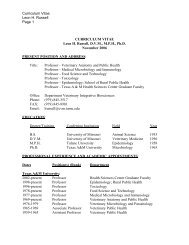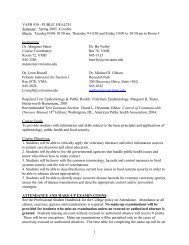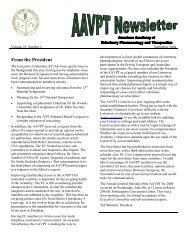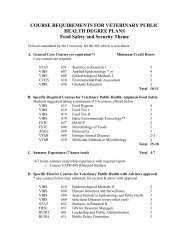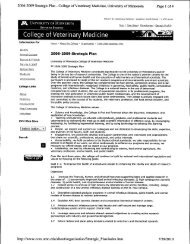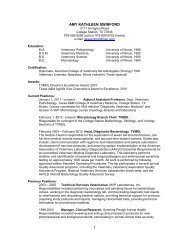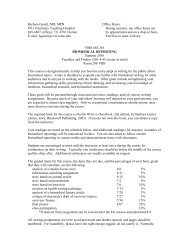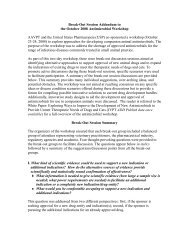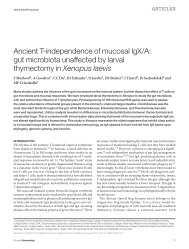Genetic Interactions between White-Tailed and Mule Deer in the ...
Genetic Interactions between White-Tailed and Mule Deer in the ...
Genetic Interactions between White-Tailed and Mule Deer in the ...
Create successful ePaper yourself
Turn your PDF publications into a flip-book with our unique Google optimized e-Paper software.
<strong>Genetic</strong> <strong>Interactions</strong> <strong>between</strong> <strong>White</strong>-<strong>Tailed</strong> <strong>and</strong> <strong>Mule</strong> <strong>Deer</strong> <strong>in</strong> <strong>the</strong> Southwestern<br />
United States<br />
James N. Derr<br />
The Journal of Wildlife Management, Vol. 55, No. 2. (Apr., 1991), pp. 228-237.<br />
Stable URL:<br />
http://l<strong>in</strong>ks.jstor.org/sici?sici=0022-541X%28199104%2955%3A2%3C228%3AGIBWAM%3E2.0.CO%3B2-U<br />
The Journal of Wildlife Management is currently published by Allen Press.<br />
Your use of <strong>the</strong> JSTOR archive <strong>in</strong>dicates your acceptance of JSTOR's Terms <strong>and</strong> Conditions of Use, available at<br />
http://www.jstor.org/about/terms.html. JSTOR's Terms <strong>and</strong> Conditions of Use provides, <strong>in</strong> part, that unless you have obta<strong>in</strong>ed<br />
prior permission, you may not download an entire issue of a journal or multiple copies of articles, <strong>and</strong> you may use content <strong>in</strong><br />
<strong>the</strong> JSTOR archive only for your personal, non-commercial use.<br />
Please contact <strong>the</strong> publisher regard<strong>in</strong>g any fur<strong>the</strong>r use of this work. Publisher contact <strong>in</strong>formation may be obta<strong>in</strong>ed at<br />
http://www.jstor.org/journals/acg.html.<br />
Each copy of any part of a JSTOR transmission must conta<strong>in</strong> <strong>the</strong> same copyright notice that appears on <strong>the</strong> screen or pr<strong>in</strong>ted<br />
page of such transmission.<br />
The JSTOR Archive is a trusted digital repository provid<strong>in</strong>g for long-term preservation <strong>and</strong> access to lead<strong>in</strong>g academic<br />
journals <strong>and</strong> scholarly literature from around <strong>the</strong> world. The Archive is supported by libraries, scholarly societies, publishers,<br />
<strong>and</strong> foundations. It is an <strong>in</strong>itiative of JSTOR, a not-for-profit organization with a mission to help <strong>the</strong> scholarly community take<br />
advantage of advances <strong>in</strong> technology. For more <strong>in</strong>formation regard<strong>in</strong>g JSTOR, please contact support@jstor.org.<br />
http://www.jstor.org<br />
Tue Jan 22 17:24:45 2008
GENETIC INTERACTIONS BETWEEN WHITE-TAILED AND<br />
MULE DEER IN THE SOUTHWESTERN UNITED STATES<br />
JAMES N. DERR,' Department of Wildlife <strong>and</strong> Fisheries Sciences, Wildlife <strong>Genetic</strong>s Laboratory, Texas A&M University, College<br />
Station,TX 77843<br />
Abstract: I used prote<strong>in</strong> electrophoresis to estimate <strong>the</strong> degree of genetic exchange <strong>between</strong> white-tailed<br />
deer (Odocoileus uirg<strong>in</strong>ianus) <strong>and</strong> mule deer (0.hemionus)from areas of sympatry throughout <strong>the</strong> south-<br />
western United States. Allelic variation from 25 presumptive gene loci were assayed from 201 deer from 31<br />
localities. Although <strong>in</strong>terspecific hybridization has been previously documented with both nuclear <strong>and</strong> mi-<br />
tochondrial markers, most areas of sympatry <strong>in</strong> <strong>the</strong> Southwest displayed little evidence of nuclear gene<br />
<strong>in</strong>trogression. Never<strong>the</strong>less, hybridization was evident from some localities with 2.0%of <strong>the</strong> white-tailed deer<br />
<strong>and</strong> 1.7%of <strong>the</strong> mule deer heterozygous at one of 2 diagnostic nuclear loci. Chang<strong>in</strong>g environmental conditions<br />
that provide a competitive advantage of 1species over <strong>the</strong> o<strong>the</strong>r may result <strong>in</strong> ephemeral areas of hybridization.<br />
Studies designed to ascerta<strong>in</strong> <strong>the</strong> ecological <strong>and</strong> concomitant behavioral changes <strong>in</strong> <strong>the</strong>se areas could be used<br />
to predict <strong>and</strong> identify potential areas of genetic <strong>in</strong>teraction <strong>between</strong> <strong>the</strong>se 2 species.<br />
<strong>White</strong>-tailed <strong>and</strong> mule (or black-tailed) deer<br />
comprise <strong>the</strong> genus Odocoileus which is distributed<br />
throughout much of <strong>the</strong> New World from<br />
Alaska to South America. The range of whitetailed<br />
deer <strong>in</strong>cludes <strong>the</strong> north temperate habitats<br />
of Canada to tropical environments of Central<br />
<strong>and</strong> South America. The distribution of mule<br />
deer extends throughout <strong>the</strong> desert <strong>and</strong> mounta<strong>in</strong>ous<br />
regions - of <strong>the</strong> western United States <strong>and</strong><br />
Canada; whereas, black-tailed deer are found<br />
along <strong>the</strong> coast of <strong>the</strong> Pacific Northwest from<br />
California to Alaska. Ranges of <strong>the</strong> 2 species<br />
overlap <strong>in</strong> <strong>the</strong> western United States <strong>and</strong> southwestern<br />
Canada. Where white-tailed <strong>and</strong> mule<br />
deer occupy <strong>the</strong> same general area, <strong>the</strong>y usually<br />
are ecologically segregated <strong>in</strong> <strong>the</strong>ir choice of<br />
habitats (Baker 1984).<br />
Analyses of allele frequencies derived from<br />
prote<strong>in</strong> electrophoresis <strong>in</strong>dicate Columbian<br />
white-tailed deer (0.v. leucurus) <strong>and</strong> Columbian<br />
black-tailed deer (0,h, columbianus) share<br />
o<strong>the</strong>rwise diagnostic alleles <strong>in</strong> low frequency<br />
(3%) at 3 presumptive gene loci <strong>in</strong> <strong>the</strong> Pacific<br />
Northwest (Gav<strong>in</strong> <strong>and</strong> May 1988). Different serum<br />
album<strong>in</strong> alleles predom<strong>in</strong>ate <strong>in</strong> each species,<br />
<strong>and</strong> <strong>the</strong> distribution of <strong>the</strong>se alleles has been<br />
used to <strong>in</strong>fer <strong>in</strong>terspecific hybridization. Stubblefield<br />
et al. (1986) estimated that 5.9% of <strong>the</strong><br />
deer sampled <strong>in</strong> west Texas had hybrid ancestry.<br />
At <strong>the</strong> Longfellow Ranch <strong>in</strong> Pecos County, Texas,<br />
Ball<strong>in</strong>ger (1987) found evidence of hybrid-<br />
' Present address: Department of Animal Sciences,<br />
Animal Breed<strong>in</strong>g <strong>and</strong> <strong>Genetic</strong>s Section, Texas A&M<br />
University, College Station, TX 77843.<br />
J. WILDL. MANAGE. 55(2):228-237<br />
ization, based on album<strong>in</strong> mobilities, from 24%<br />
of <strong>the</strong> deer sampled. In Montana, 2% of <strong>the</strong><br />
<strong>in</strong>dividuals exam<strong>in</strong>ed bv Cron<strong>in</strong> et al. 11988)<br />
also shared album<strong>in</strong> alleies that were othkrwise<br />
diagnostic at this locus. These studies document<br />
<strong>the</strong> potential for hybridization <strong>in</strong> areas of sym-<br />
patry; however, Stubblefield et al. (1986) <strong>and</strong><br />
Cron<strong>in</strong> et al. (1988) only exam<strong>in</strong>ed <strong>the</strong> products<br />
of 1gene system, <strong>and</strong> Ball<strong>in</strong>ger (1987) restricted<br />
his analysis to a s<strong>in</strong>gle location.<br />
Restriction endonuclease site mapp<strong>in</strong>g of mi-<br />
tochondrial deoxyribonucleic acid (mtDNA) also<br />
provides evidence of genetic <strong>in</strong>teractions be-<br />
tween <strong>the</strong> 2 species. Because mtDNA is mater-<br />
nally <strong>in</strong>herited <strong>and</strong> lacks recomb<strong>in</strong>ation, this<br />
molecule can be considered a s<strong>in</strong>gle haploid lo-<br />
cus for population genetic analyses. As compared<br />
with allozvme data, white-tailed <strong>and</strong> mule<br />
deer <strong>in</strong> Montana have dist<strong>in</strong>ct but similar<br />
mtDNA haplotypes (Cron<strong>in</strong> et al. 1988). In con-<br />
trast, Carr et al. (1986) <strong>and</strong> Ball<strong>in</strong>ger (1987)<br />
found that white-tailed <strong>and</strong> mule deer shared a<br />
mtDNA haplotype on <strong>the</strong> Longfellow Ranch <strong>in</strong><br />
west Texas, suggest<strong>in</strong>g cytoplasmic gene flow.<br />
These studies also reveal that <strong>the</strong> sequence di-<br />
vergence of mtDNA haplotypes <strong>between</strong> white-<br />
tailed <strong>and</strong> mule deer is much less than <strong>the</strong> di-<br />
vergence <strong>between</strong> subspecies of 0, hemionus<br />
(mule deer <strong>and</strong> black-tailed deer). One <strong>in</strong>ter-<br />
pretation of this f<strong>in</strong>d<strong>in</strong>g is historical <strong>in</strong>trogres-<br />
sion of mtDNA from white-tailed deer to mule<br />
deer, <strong>in</strong>dependent of black-tailed deer (Carr et<br />
al. 1986, Cron<strong>in</strong> et al. 1988, Derr 1990). These<br />
studies <strong>in</strong>dicate <strong>the</strong> potential for nuclkar <strong>and</strong><br />
cytoplasmic gene flow <strong>between</strong> white-tailed <strong>and</strong><br />
mule deer.
J. Wildl. Manage. 55(2):1991 DEER GENETICS Dew 229<br />
Fig. 1. Geographic distribution of <strong>the</strong> localities sampled for white-tailed, mule, <strong>and</strong> Mack-tailed deer. (See Appendix A for<br />
description of locations, abbreviations, <strong>and</strong> samples sizes.)<br />
The goal of my study was to evaluate <strong>the</strong><br />
extent of genetic <strong>in</strong>teractions <strong>between</strong> <strong>the</strong> 2 species<br />
<strong>in</strong> <strong>the</strong> southwestern United States based on<br />
nuclear genetic markers <strong>and</strong> to compare this<br />
<strong>in</strong>formation to <strong>the</strong> mtDNA results of Carr et al.<br />
(1986). Subsequently, I estimated <strong>the</strong> effect of<br />
<strong>in</strong>trogression, as demonstrated by cytoplasmic<br />
gene flow (mtDNA), on <strong>the</strong> <strong>in</strong>tegrity of <strong>the</strong> nuclear<br />
gene pools associated with white-tailed <strong>and</strong><br />
mule deer.<br />
I acknowledge J. W. Bickham, L. H. Blankenship,<br />
I. F. Greenbaum, <strong>and</strong> D. J. Schmidly for<br />
encouragement <strong>and</strong> advice. R. M. Atk<strong>in</strong>s, T. E.<br />
Lee, <strong>and</strong> J. C. Morales provided helpful com-<br />
Tissue preparation <strong>and</strong> histochemical sta<strong>in</strong><strong>in</strong>g<br />
were conducted accord<strong>in</strong>g to Sel<strong>and</strong>er et al.<br />
(1971) <strong>and</strong> Harris <strong>and</strong> Hopk<strong>in</strong>son (1976). Elec-<br />
trophoretic procedures were essentially those<br />
described by Sel<strong>and</strong>er et al. (1971). I assigned<br />
alleles numerical designations based on <strong>the</strong> mobilities<br />
of <strong>the</strong> prote<strong>in</strong> products relative to <strong>the</strong><br />
most common electromorph among samples of<br />
white-tailed deer (designated 100 if anodal or<br />
- 100 if cathodal). (See Appendix B for buffer<br />
systems used, enzyme commission numbers<br />
[E.C.], <strong>and</strong> prote<strong>in</strong> abbreviations.)<br />
I used BIOSYS-1 (Swofford <strong>and</strong> Sel<strong>and</strong>er 1981)<br />
<strong>and</strong> BIOSTAT-1 (Pimentel <strong>and</strong> Smith 1986) to<br />
ments on earlier drafts of this manuscri~t. I am analyze allelic variation. Descriptive statistics<br />
also <strong>in</strong>debted to <strong>the</strong> many <strong>in</strong>dividuals that pro- <strong>in</strong>cluded mean heterozygosity (H), proportion<br />
vided tissue samples for analysis. Fund<strong>in</strong>g was of loci polymorphic (P), <strong>and</strong> <strong>the</strong> mean number<br />
through a Tom Slick Fellowship, Texas Agri- of alleles per locus (A). Statistical significance<br />
culture Experiment Station Exp<strong>and</strong>ed ~eseaich was addressed with a Mann-Whitney U non-<br />
Area, <strong>and</strong> Program Development Funds 24464. parametric test. Deviation from Hardy-We<strong>in</strong>berg<br />
equilibrium was tested with Fisher's exact<br />
METHODS AND MATERIALS<br />
test. Fixation <strong>in</strong>dices (F..) . "., (Van . Den Bussche et<br />
Liver samples were obta<strong>in</strong>ed from 201 hunt- al. 1986) were calculated to measure genetic<br />
er-killed deer at 31 localities (Fig. 1) from 1984 differentiation among populations with<strong>in</strong> speto<br />
1988. Species identification was made <strong>in</strong> <strong>the</strong> cies.<br />
field us<strong>in</strong>g st<strong>and</strong>ard morphological characters Coefficients of genetic distance <strong>and</strong> identity<br />
(Wallmo 1981). Voucher tissues were deposited (Nei 1972, Rogers 1972) were calculated for all<br />
<strong>in</strong> <strong>the</strong> frozen tissue collection, Texas Coopera- pair-wise population comparisons of <strong>the</strong> 2 spetive<br />
Wildlife Collection, Texas A&M University, cies. Previous genetic studies of white-tailed <strong>and</strong><br />
College Station. (See Appendix A for collection mule deer have reported distance values callocalities,<br />
abbreviations, <strong>and</strong> sample sizes.) culated by <strong>the</strong> methods of both Nei (1972) <strong>and</strong><br />
-
230 DEERGENETICSDerr J. Wildl. Manage. 55(2):1991<br />
Table 1. AMi Srequency <strong>and</strong> fixation <strong>in</strong>dices for <strong>the</strong> polymorphic loci among populations of Odocoileus sampled. Localities<br />
are as <strong>in</strong> Figure 1.<br />
Species ACPH ALB GPDl lDHl MDH2 MP1<br />
<strong>and</strong><br />
population n 100 -100 100 103 100 145 86 100 94 -100 -140 100 118 82<br />
<strong>White</strong>-tailed deer<br />
AZWT 7 0.00 1.00<br />
COWT 8 0.00 1.00<br />
CRWT 1 0.00 1.00<br />
EPWT 8 0.00 1.00<br />
FRWT 4 0.00 1.00<br />
HUWT 5 0.00 1.00<br />
IMWT 7 0.00 1.00<br />
JUWT 5 0.00 1.00<br />
MAWT 5 0.00 1.00<br />
MIWT 14 0.00 1.00<br />
PKWT 15 0.07 0.93<br />
SRWT 5 0.00 1.00<br />
SAWT 8 0.00 1.00<br />
WT FST 0.058<br />
Black-tailed deer<br />
ALBT 1 1.00 0.00<br />
HOBT 5 1.00 0.00<br />
<strong>Mule</strong> deer<br />
AZMD 8 1.00 0.00<br />
BTMD 10 1.00 0.00<br />
CHMD 3 1.00 0.00<br />
CMMD 3 1.00 0.00<br />
DDMD 5 1.00 0.00<br />
EPMD 9 1.00 0.00<br />
FRMD 6 1.00 0.00<br />
IMMD 7 1.00 0.00<br />
IRMD 10 1.00 0.00<br />
KMMD 5 1.00 0.00<br />
MIMD 2 1.00 0.00<br />
MOMD 10 1.00 0.00<br />
NMMD 1 1.00 0.00<br />
PKMD 11 1.00 0.00<br />
TRMD 6 1.00 0.00<br />
UTMD 7 1.00 0.00<br />
MD Fw O.Oo0<br />
Rogers (1972). For comparison with published<br />
values, I calculated both estimates of genetic<br />
distance. I also exam<strong>in</strong>ed phenetic relationships<br />
among populations with <strong>the</strong> unweighted pair<br />
group matrix analysis (UPGMA) algorithm of<br />
Sneath <strong>and</strong> Sokal (1973).<br />
RESULTS<br />
Allelic Variation.-The products of 25 presumptive<br />
gene loci were assessed <strong>in</strong> a prelim<strong>in</strong>ary<br />
survey of 15 white-tailed deer, 10 mule<br />
deer, <strong>and</strong> 5 black-tailed deer. Ten loci were<br />
polymorphic, <strong>in</strong>clud<strong>in</strong>g eight for white-tailed<br />
deer <strong>and</strong> eight for mule deer (Table 1).Animals<br />
from all populations were surveyed for allelic<br />
variation at each polymorphic locus; however,<br />
due to variation <strong>in</strong> tissue quality, only 94.6% of<br />
this data matrix was complete. Two of <strong>the</strong> polymorphic<br />
loci among all populations deviated<br />
from Hardy-We<strong>in</strong>berg equilibrium. <strong>White</strong>tailed<br />
deer from <strong>the</strong> Eppenhauer Ranch (EPWT)<br />
had a heterozygote deficiency for MPI (P =<br />
0.03), <strong>and</strong> mule deer from <strong>the</strong> Brite Ranch<br />
(BTMD) had a heterozygote excess at PGD (P<br />
= 0.045). Observed mean heterozygosity (A)<br />
was 0.056 +. 0.026 (SE) for white-tailed deer<br />
<strong>and</strong> 0.037 + 0.022 for mule <strong>and</strong> black-tailed<br />
deer. A Mann-Whitney U 2-sample test failed<br />
to reject <strong>the</strong> null hypo<strong>the</strong>sis of equivalent observed<br />
heterozygosity values <strong>between</strong> <strong>the</strong> 2 species<br />
(P < 0.01). The difference <strong>in</strong> mean number<br />
of alleles per locus (A) for white-tailed deer<br />
(1.52)<strong>and</strong> mule <strong>and</strong> black-tailed deer (1.40)was<br />
not significant (P < 0.01).The proportion of loci
J. Wildl. Manage. 55(2):1991<br />
Table 1. Extended<br />
100<br />
PEPD<br />
94 88<br />
PEPE<br />
100 96 100<br />
polymorphic (P)was <strong>the</strong> same for both species<br />
(32.0%).<br />
Profound differences <strong>in</strong> allozymic frequen-<br />
cies dist<strong>in</strong>guished populations of white-tailed<br />
deer from those of mule <strong>and</strong> black-tailed deer.<br />
The products of 2 presumptive loci, ACPH <strong>and</strong><br />
ALB, displayed nearly fixed allelic differences<br />
<strong>between</strong> samples of <strong>the</strong> 2 species. All white-<br />
tailed deer at <strong>the</strong> ACPH locus, except for 1<br />
<strong>in</strong>dividual (PKWT), were homozygous for <strong>the</strong><br />
ACPH -100 allelle, <strong>and</strong> all mule <strong>and</strong> black-<br />
tailed deer were homozygous for <strong>the</strong> ACPH 100<br />
allele. For .4LB, 2 of <strong>the</strong> 92 white-tailed deer<br />
sampled (from AZWT <strong>and</strong> IMWT) were het-<br />
erozygous for <strong>the</strong> ALB 100/103 alleles All re-<br />
ma<strong>in</strong><strong>in</strong>g white-tailed deer were homozygous for<br />
<strong>the</strong> ALB 100 allele. Two of <strong>the</strong> 103 mule deer<br />
PGD<br />
118 109 73 -100 -120<br />
SDH<br />
-105 -92 -84<br />
sampled (from TRMD <strong>and</strong> KMMD) were het-<br />
erozygous (100/103) at <strong>the</strong> ALB locus; whereas,<br />
all o<strong>the</strong>rs were homozygous for <strong>the</strong> ALB 103<br />
allele. Each of <strong>the</strong> 6 black-tailed deer exam<strong>in</strong>ed<br />
were homozygous for <strong>the</strong> ALB 103 allele.<br />
Not all sympatric localities exhibit evidence<br />
of genetic <strong>in</strong>teraction. For example, both species<br />
had fixed ACPH <strong>and</strong> ALB allelic differences on<br />
<strong>the</strong> Friends Ranch (FRWTIFRMD, n = 10) <strong>and</strong><br />
<strong>the</strong> McIvior Ranch (MITWIMIMD, n = 16).<br />
From sympatric localities both species displayed<br />
similar effects of <strong>in</strong>trogression with 3of 64 (2.0%)<br />
white-tailed deer <strong>and</strong> 2 of 86 (1.7%) mule deer<br />
heterozygous at one of <strong>the</strong> 2 marker nuclear<br />
loci.<br />
Allele frequency differences at 4 o<strong>the</strong>r pre-<br />
sumptive loci provided additional evidence of
232 DEERGENETICS Derr J. Wildl. Manage. 55(2):1991<br />
Table 2. Coefficientsof genetic distance <strong>and</strong> identity among<br />
<strong>and</strong> <strong>between</strong> samples of Odocoileus virg<strong>in</strong>ianus (white-tailed<br />
deer) <strong>and</strong> 0. hemionus (black-tailed <strong>and</strong> mule deer).<br />
Coefficient <strong>and</strong> comparison Range<br />
Distance (Rogers 1972)<br />
Populations<br />
<strong>White</strong>-tailed deer 0.011-0.086<br />
<strong>Mule</strong> deer 0.000-0.071<br />
Between species 0.102-0.206<br />
Taxa<br />
<strong>White</strong>-tailed vs<br />
mule deer<br />
<strong>White</strong>-tailed vs.<br />
black-tailed deer<br />
<strong>Mule</strong> vs.<br />
black-tailed deer<br />
Distance (Nei 1972)<br />
Populations<br />
<strong>White</strong>-tailed deer<br />
<strong>Mule</strong> deer<br />
Between species<br />
Taxa<br />
<strong>White</strong>-tailed vs.<br />
mule deer<br />
<strong>White</strong>-tailed vs.<br />
black-tailed deer<br />
<strong>Mule</strong> vs.<br />
black-tailed deer<br />
Identity (Nei 1972)<br />
Populations<br />
<strong>White</strong>-tailed deer<br />
<strong>Mule</strong> deer<br />
Between species<br />
genetic divergence. <strong>White</strong>-tailed deer allele frequencies<br />
were almost equally split <strong>between</strong> <strong>the</strong><br />
GPDl allele 100 (0.465) <strong>and</strong> GPDl allele 145<br />
(0.529),whereas all mule deer except one (0.995)<br />
<strong>and</strong> all black-tailed deer had <strong>the</strong> GPDl 145<br />
allele. Similar allele frequencies occurred at <strong>the</strong><br />
MPI locus where white-tailed deer displayed<br />
both <strong>the</strong> MPI 100 allele <strong>and</strong> <strong>the</strong> MPI 118 allele<br />
<strong>in</strong> roughly equal frequencies (0.596 <strong>and</strong> 0.404,<br />
respectively), whereas mule <strong>and</strong> black-tailed<br />
deer predom<strong>in</strong>ately had <strong>the</strong> MPI 100 allele<br />
(0.950).Only two of <strong>the</strong> 4 alleles resolved from<br />
<strong>the</strong> PGD locus were common <strong>in</strong> ei<strong>the</strong>r species.<br />
The PGD 100 allele was <strong>the</strong> most common allele<br />
from white-tailed deer (0.886),whereas <strong>the</strong> PGD<br />
73 allele was <strong>the</strong> most frequently encountered<br />
allele at this locus from mule deer (0.619). All<br />
black-tailed deer had <strong>the</strong> PGD 100 allele. Of<br />
<strong>the</strong> 5 alleles determ<strong>in</strong>ed at <strong>the</strong> SDH locus, SDH<br />
-100 was <strong>the</strong> most common allele <strong>in</strong> whitetailed<br />
deer (0.766), <strong>and</strong> <strong>the</strong> SDH -105 was <strong>the</strong><br />
most frequent allele from mule deer (0.815).<br />
DISTANCE<br />
WHITE-TAILED DEER<br />
SRWT \<br />
AZWT<br />
COWT<br />
CRWT<br />
B)cc. = 0.969 MIWT<br />
IMWT<br />
SAWT<br />
MAWT<br />
PKWT<br />
HUWT<br />
JUWT /<br />
4AZMD )<br />
/ IMMD I<br />
UTMD<br />
MOMD<br />
DDMD<br />
PKMD<br />
FRMD<br />
IRMD<br />
TRMD<br />
NMMD<br />
WH!TE.TAlLED<br />
DEER<br />
MULE AND<br />
BLACK.TA1LED<br />
DEER<br />
Fig. 2. Cluster<strong>in</strong>g of distance values among (A) white-tailed,<br />
mule, <strong>and</strong> black-taileddeer <strong>and</strong> (B)for each locality exam<strong>in</strong>ed.<br />
(See Appendix A for description of locations, abbreviations,<br />
<strong>and</strong> samples sizes.)<br />
One SDH allele (SDH -92) was unique to California<br />
black-tailed deer (HOBT).<br />
Efforts to resolve an additional enzyme, galactosam<strong>in</strong>idase<br />
(E.C.3.2.1.53),reported as species-specific<br />
by Gav<strong>in</strong> <strong>and</strong> May (1988), proved<br />
unsuccessful. These authors reported 2 alleles at<br />
this locus from <strong>the</strong> Pacific Northwest, one of<br />
which was unique to white-tailed deer; <strong>the</strong> o<strong>the</strong>r<br />
was restricted to mule <strong>and</strong> black-tailed deer.<br />
<strong>Genetic</strong> Distance.-Estimates of mean genetic<br />
distance <strong>between</strong> species were 0.135 (Nei<br />
1972) <strong>and</strong> 0.160 (Rogers 1972). Mean identity<br />
values (Nei 1972) among populations were similar<br />
for both white-tailed <strong>and</strong> mule deer; I =<br />
0.982 <strong>and</strong> I =0.983,respectively (Table2).Cluster<br />
analysis constructed from <strong>the</strong> coefficients of<br />
genetic distance (Table 2) grouped white-tailed,<br />
mule, <strong>and</strong> black-tailed deer, which is consistent<br />
with <strong>the</strong>ir current taxonomic relationship (Fig.<br />
2A). In <strong>the</strong> phenogram cluster<strong>in</strong>g <strong>in</strong>dividual<br />
populations of <strong>the</strong> 2 species (Fig. 2B), samples<br />
of white-tailed deer clustered at values
J. Wildl. Manage. 55(2):1991 DEERGENETICSDerr 233<br />
assemblage at <strong>the</strong> mean <strong>in</strong>terspecific distance of<br />
0.160.<br />
Quantitative evidence of divergence <strong>between</strong><br />
species also reveals marked differences. Nei's<br />
(1972)genetic distance <strong>between</strong> white-tailed <strong>and</strong><br />
mule deer (D = 0.135, based on 25 loci) was<br />
identical to <strong>the</strong> value reported by Gav<strong>in</strong> <strong>and</strong><br />
May (1988)based on 35 loci <strong>and</strong> was also similar<br />
to that reported by Baccus et al. (1983) (Nei's<br />
D = 0.149; based on 19 loci). Ball<strong>in</strong>ger (1987)<br />
reported a Nei's D = 0.050 <strong>and</strong> Rogers' D =<br />
0.086 from <strong>the</strong> Longfellow Ranch <strong>in</strong> west Texas.<br />
These reduced distance values, compared with<br />
<strong>the</strong> above published reports, were <strong>in</strong>terpreted<br />
as <strong>the</strong> result of <strong>in</strong>trogressive hybridization at<br />
that location. Although <strong>the</strong> relationship <strong>between</strong><br />
genetic distance <strong>and</strong> taxonomic categories are<br />
quite variable, <strong>the</strong> values observed <strong>between</strong><br />
white-tailed <strong>and</strong> mule deer fall with<strong>in</strong> <strong>the</strong> range<br />
of those reported from o<strong>the</strong>r <strong>in</strong>trageneric comparisons<br />
of mammalian taxa (Avise <strong>and</strong> Aquadro<br />
1982). The estimates of genetic distance <strong>between</strong><br />
mule <strong>and</strong> black-tailed deer (D = 0.031)<br />
are higher than those previously reported (Nei's<br />
D = 0.018) (Gav<strong>in</strong> <strong>and</strong> May 1988).<br />
Phenetic cluster<strong>in</strong>g of distance values revealed<br />
evidence of biogeographic structur<strong>in</strong>g<br />
among some white-tailed deer populations (Fig.<br />
2).For example, <strong>the</strong> first major white-tailed deer<br />
assemblage (<strong>in</strong> Fig. 2B) <strong>in</strong>cludes <strong>the</strong> 2 Arizona<br />
white-tailed deer localities (AZWT <strong>and</strong> COWT),<br />
all west Texas white-tailed deer localities<br />
(CRWT, MIWT, EPWT, FRWT, <strong>and</strong> IMWT)<br />
except PKWT, <strong>and</strong> <strong>the</strong> most geographically distant<br />
white-tailed deer population, SRWT, from<br />
South Carol<strong>in</strong>a. <strong>White</strong>-tailed deer from <strong>the</strong><br />
PKWT locality clustered with <strong>the</strong> rema<strong>in</strong><strong>in</strong>g<br />
non-west Texas populations form<strong>in</strong>g <strong>the</strong> second<br />
major white-tailed deer assemblage. Conversely,<br />
little geographic structure is evident across<br />
mule deer populations. Notable exceptions <strong>in</strong>clude<br />
<strong>the</strong> placement of black-tailed deer from<br />
California (HOBT), which connects to all o<strong>the</strong>r<br />
mule deer at values
234 DEERGENETICSDerr J. Wildl. Manage. 55(2):1991<br />
zygotes, respectively, for white-tailed <strong>and</strong> mule<br />
deer). Moreover, 3 of <strong>the</strong> 46 mule deer Ball<strong>in</strong>ger<br />
(1987)sampled from <strong>the</strong> Longfellow Ranch were<br />
homozygous for <strong>the</strong> ALB 100 allele. Large populations<br />
of both species occur on <strong>the</strong> Longfellow<br />
Ranch primarily due to restricted hunt<strong>in</strong>g <strong>and</strong><br />
<strong>the</strong> availability of large tracts of suitable habitat.<br />
The Longfellow Ranch also <strong>in</strong>cludes ecotone<br />
areas <strong>between</strong> typical habitat of white-tailed<br />
<strong>and</strong> mule deer that are extensively used by both<br />
species (L. H. Blankenship, Uvalde, Tex., pers.<br />
commun.). These factors may contribute to <strong>the</strong><br />
high <strong>in</strong>cidence of hybridization Ball<strong>in</strong>ger (1987)<br />
reported from this ranch.<br />
O<strong>the</strong>r reports represent<strong>in</strong>g >2,000 whitetailed<br />
deer from throughout <strong>the</strong> eastern <strong>and</strong><br />
central United States (Baccus et al. 1983, Smith<br />
et al. 1984, Sheffield et al. 1985, Kennedy et al.<br />
1987, Breshears et al. 1988) found only 2 ALB<br />
heterozygotes (from Mich.) (Manlove 1979).<br />
From mule deer populations <strong>in</strong> Colorado, Scribner<br />
et al. (1990) reported that 2.9% of <strong>the</strong> animals<br />
<strong>the</strong>y exam<strong>in</strong>ed were heterozygous for ALB.<br />
The only comparable <strong>in</strong>formation on ACPH allelic<br />
variation from sympatric populations is that<br />
of Gav<strong>in</strong> <strong>and</strong> May (1988). These authors reported<br />
that 2% of <strong>the</strong> white-tailed deer <strong>and</strong> no<br />
mule deer were heterozygous at this locus. O<strong>the</strong>r<br />
studies reported 2 ACPH alleles from whitetailed<br />
deer populations (Hillestad 1984, Smith<br />
et al. 1984, Kennedy et al. 1987), but nei<strong>the</strong>r<br />
appeared to be <strong>the</strong> same as <strong>the</strong> common allele<br />
(ACPH -100)found <strong>in</strong> mule deer. In my study,<br />
all allopatric populations of both species had<br />
fixed allelic differences at <strong>the</strong> ALB <strong>and</strong> ACPH<br />
loci. Except for <strong>the</strong> Longfellow Ranch (Ball<strong>in</strong>ger<br />
1987)<strong>and</strong> possibly <strong>the</strong> Iron Mounta<strong>in</strong> Ranch<br />
(Stubblefield et al. 1986),white-tailed <strong>and</strong> mule<br />
deer from sympatric localities <strong>in</strong> west Texas,<br />
Montana, <strong>and</strong> <strong>the</strong> Pacific Northwest share rare<br />
alleles at <strong>the</strong>se 2 loci <strong>in</strong> roughly equal frequencies.<br />
Based on <strong>the</strong> similarity of <strong>the</strong>ir mtDNA haplotypes,<br />
differential cytoplasmic <strong>in</strong>trogression <strong>in</strong><br />
<strong>the</strong> past may have established white-tailed deer<br />
mtDNA among mule deer populations (Carr et<br />
al. 1986, Ball<strong>in</strong>ger 1987,Cron<strong>in</strong> et al. 1988, Derr<br />
1990). This historical aspect of <strong>in</strong>terspecific genetic<br />
exchange is not readily apparent from <strong>the</strong><br />
allozymic data. In spite of <strong>the</strong> mtDNA <strong>in</strong>trogression,<br />
<strong>the</strong> 2 species have coexisted over extended<br />
areas with little or, <strong>in</strong> many areas, no evidence<br />
of extensive nuclear <strong>in</strong>trogression. Although <strong>the</strong><br />
genetic structure of local populations may be<br />
altered, overall, hybridization does not seem to<br />
present a significant threat to <strong>the</strong> nuclear gene<br />
pools, hence <strong>the</strong> genetic <strong>in</strong>tegrity of ei<strong>the</strong>r species.<br />
Natural hybridization <strong>between</strong> fully differentiated<br />
<strong>and</strong> morphologically dist<strong>in</strong>ct species is<br />
not uncommon. Although local populations may<br />
be disrupted, <strong>the</strong> genetic <strong>in</strong>tegrity of <strong>the</strong> parental<br />
species is rarely threatened (Carson et al.<br />
1989). Observations such as <strong>the</strong>se led Paterson<br />
(1985),<strong>and</strong> more recently Templeton (1989),to<br />
argue that <strong>the</strong> gene pool of a species is dist<strong>in</strong>ct<br />
from o<strong>the</strong>rs primarily by <strong>the</strong> positive forces of<br />
strong balanc<strong>in</strong>g selection that operate with<strong>in</strong><br />
each species to ma<strong>in</strong>ta<strong>in</strong> its own optimal reproductive<br />
mode. The coherence of a gene pool,<br />
<strong>the</strong>refore, is a much better basis for <strong>the</strong> characterization<br />
of a species than reproductive isolation.<br />
Accord<strong>in</strong>gly, although white-tailed <strong>and</strong><br />
mule deer share identical mtDNA haplotypes<br />
<strong>in</strong> some areas, <strong>the</strong> nuclear genomes of both species<br />
clearly represent discrete genetic entities<br />
<strong>and</strong> are <strong>the</strong> result of <strong>in</strong>dependent evolutionary<br />
l<strong>in</strong>eages.<br />
What conditions contribute to <strong>the</strong> disruption<br />
of this "coherent gene pool" <strong>and</strong> allow hybridization<br />
<strong>in</strong> some geographic areas <strong>and</strong> not o<strong>the</strong>rs?<br />
One possible explanation is that environmental<br />
factors <strong>in</strong> many areas of <strong>the</strong> Southwest have<br />
played an important role <strong>in</strong> provid<strong>in</strong>g reproductive<br />
contact. In west Texas, white-tailed deer<br />
have exp<strong>and</strong>ed <strong>the</strong>ir range <strong>in</strong>to typical mule<br />
deer habitat primarily because of ecological<br />
changes related to domestic livestock production<br />
(Baker 1984). In o<strong>the</strong>r areas of <strong>the</strong> West,<br />
<strong>the</strong> desert chaparral of Arizona for example,<br />
environmental factors that favor mule deer have<br />
allowed that species to <strong>in</strong>habit areas that were<br />
once <strong>the</strong> sole doma<strong>in</strong> of white-tailed deer (Anthony<br />
<strong>and</strong> Smith 1977). All <strong>in</strong>dividuals I identified<br />
with prote<strong>in</strong> electrophoresis as hav<strong>in</strong>g hybrid<br />
ancestry (i.e., heterozygotes at ei<strong>the</strong>r <strong>the</strong><br />
ACPH or ALB loci) were from localities that<br />
<strong>in</strong>clude ecotonal areas <strong>between</strong> suitable habitat<br />
for both species. Studies designed to ascerta<strong>in</strong><br />
<strong>the</strong> ecological <strong>and</strong> concomitant behavioral<br />
changes <strong>in</strong> <strong>the</strong>se areas may allow for <strong>the</strong> prediction<br />
or identification of potential areas of<br />
genetic <strong>in</strong>teraction.<br />
These chang<strong>in</strong>g environmental conditions that<br />
allow 1 species to move <strong>in</strong>to <strong>the</strong> range of <strong>the</strong><br />
o<strong>the</strong>r may provide temporary areas of hybridization.<br />
No stable zone of hybridization, <strong>in</strong> <strong>the</strong><br />
traditional sense, is evident. Hybrid zone models<br />
proposed by Endler (1977), Moore (1977), <strong>and</strong><br />
Barton <strong>and</strong> Hewitt (1981, 1985) differ <strong>in</strong> <strong>the</strong>ir
J. Wildl. Manage. 55(2):1991 DEERGENETICS Derr 235<br />
<strong>in</strong>terpretation of <strong>the</strong> role of environmental factors<br />
<strong>and</strong> <strong>the</strong> effect of selection on <strong>the</strong> ma<strong>in</strong>tenance<br />
of <strong>the</strong>se zones. However, each def<strong>in</strong>es<br />
hybrid zones as cl<strong>in</strong>es that may be characterized<br />
from samples collected along l<strong>in</strong>ear transects<br />
across <strong>the</strong> zone (Harrison <strong>and</strong> R<strong>and</strong> 1989). Hybridization<br />
<strong>between</strong> white-tailed <strong>and</strong> mule deer<br />
occurs <strong>in</strong> a mosaic of <strong>in</strong>dependent <strong>and</strong> isolated<br />
pockets that are strongly associated with ecological<br />
parameters. Nontraditional hybrid zones<br />
of this fashion have been reported for o<strong>the</strong>r<br />
closely related species (Howard 1986, Sperl<strong>in</strong>g<br />
1987, Harrison <strong>and</strong> R<strong>and</strong> 1989). These mosaic<br />
hybrid zones may have gone unnoticed because<br />
<strong>the</strong> patterns of variation are not as strik<strong>in</strong>g as<br />
<strong>the</strong> steep cl<strong>in</strong>es <strong>and</strong> clear discont<strong>in</strong>uities that<br />
characterize <strong>the</strong> more traditional zones (Harrison<br />
<strong>and</strong> R<strong>and</strong> 1989). Moreover, nontraditional<br />
hybrid zones may be ephemeral, exist<strong>in</strong>g for 1<br />
or a few generations, <strong>and</strong> may be sporadically<br />
distributed throughout an area of sympatry.<br />
LITERATURE CITED<br />
riKTElONY, R. G.;AKD N. S. SMITH. 1977. Ecological<br />
relationships <strong>between</strong> mule deer <strong>and</strong> white-tailed<br />
deer <strong>in</strong> sou<strong>the</strong>astern Arizona. Ecol. Monogr. 47:<br />
255-277.<br />
AXISE,J. C., AKD C. F. AQVADRO.1982. A comparative<br />
summary of genetic distances <strong>in</strong> <strong>the</strong> vertebrates.<br />
Pages 151-185 <strong>in</strong> M. K. Hecht, B. Wallace,<br />
<strong>and</strong> G. Prance, eds. Evolutionary biology.<br />
Plenum Press, New York, N.Y.<br />
B~ccvs.R., N. RYMAS.PI.1. H. SMITH,C. REUTER-<br />
WAL.~., AND D. CAME~O~. 1983. <strong>Genetic</strong> variability<br />
<strong>and</strong> differentiation of large graz<strong>in</strong>g mammals.<br />
J. Mammal. 64:109-120.<br />
BAKER,R. H. 1984. Orig<strong>in</strong>, classification <strong>and</strong> distribution.<br />
Pages 1-18 <strong>in</strong> L. K. Halls, ed. <strong>White</strong>tailed<br />
deer: ecology <strong>and</strong> management. Stackpole<br />
Books, Harrisburg, Pa.<br />
B-~LLINCER, S. W. 1987. Allozymic <strong>and</strong> mitochon-<br />
drial DNA analysis of sympatric white-tailed <strong>and</strong><br />
mule deer <strong>in</strong> west Texas. M.S. Thesis, Texas A&M<br />
L'niv., College Station. 48pp.<br />
BARTON.N. H., ~ N DG. M. HEWITT. 1981. Hybrid<br />
zones <strong>and</strong> speciation. Pages 109-145 <strong>in</strong> U'. R.<br />
Atchley <strong>and</strong> D. S. Woodruff, eds. Evolution <strong>and</strong><br />
speciation: essays <strong>in</strong> honour of M. J. D. <strong>White</strong>.<br />
Cambridge Univ. Press, U.K.<br />
,AND -. 1985. Analysis of hybrid zones.<br />
patric Hawaiian species Drosophila silvestris <strong>and</strong><br />
Drosophila heteroneura. Evolution 3:190-203.<br />
CLAYTON, J. W., AND D. N. TRETIAK.1972. Am<strong>in</strong>ecitrate<br />
buffers for pH control <strong>in</strong> starch gel electrophoresis.<br />
J. Fish. Res. Can. 29:1169-1172.<br />
CRONIN,M. A,, E. R. VYSE,AND D. G. CAMERON.<br />
1988. <strong>Genetic</strong> relationships <strong>between</strong> mule deer<br />
<strong>and</strong> white-tailed deer <strong>in</strong> Montana. J. Wildl. Manage.<br />
52:320-328.<br />
DAY,G. I. 1980. Characteristics <strong>and</strong> measurements<br />
of captive hybrid deer <strong>in</strong> Arizona. Southwest.<br />
Nat. 52320-328.<br />
DERR,J. N. 1990. <strong>Genetic</strong> <strong>in</strong>teractions <strong>between</strong> two<br />
species of North American deer, Odocoileus virg<strong>in</strong>ianus<br />
<strong>and</strong> 0 . hemionus. Ph.D. Thesis, Texas<br />
A&M Univ., College Station. 11lpp.<br />
ENDLER, J. A. 1977. Geographic variation, specia-<br />
tion <strong>and</strong> cl<strong>in</strong>es. Pr<strong>in</strong>ceton Univ. Press, N.J. 246pp.<br />
GAVIN,T. A,, PlND B. MAY. 1988. Taxonomic status<br />
<strong>and</strong> genetic purity of Columbian white-tailed<br />
deer. J. Wildl. Manage. 52:l-10.<br />
HARRIS,H., AND D. H. HOPKINSON.1976. H<strong>and</strong>book<br />
of enzyme electrophoresis <strong>in</strong> human ge-<br />
netics. Am. Elsevier, New York, N.Y.<br />
H.~RRISON, R. G., AND D. M. RAND. 1989. Mosaic<br />
hybrid zones <strong>and</strong> <strong>the</strong> nature of species bounda&.<br />
Pages 111-133 <strong>in</strong> D. Otta <strong>and</strong> J. L. Endler,<br />
eds. Speciation <strong>and</strong> its consequences. S<strong>in</strong>auer Assoc.,<br />
Sunderl<strong>and</strong>, Mass.<br />
HILLESTAD, H. 0. 1984. Stock<strong>in</strong>g <strong>and</strong> genetic variability<br />
of white-tailed deer <strong>in</strong> <strong>the</strong> sou<strong>the</strong>astern<br />
United States. Ph.D. Thesis, Univ. Georgia. A<strong>the</strong>ns.<br />
112pp.<br />
HOWARD,D. J. 1986. A zone of overlap <strong>and</strong> hybridization<br />
<strong>between</strong> two ground cricket species.<br />
Evolution 40:34-43.<br />
KESNEDY,P. K., M. L. KENNEDY, AND M. L. BECK.<br />
1987. <strong>Genetic</strong> variability <strong>in</strong> white-tailed deer<br />
(Odocoileus uirg<strong>in</strong>ianus) <strong>and</strong> its relationship to<br />
environmental parameters <strong>and</strong> herd orig<strong>in</strong> (Cervidae).<br />
<strong>Genetic</strong>a 74:189-201.<br />
MNLOVE, M. N. 1979. <strong>Genetic</strong> similarity among<br />
contiguous <strong>and</strong> isolated populations of whitetailed<br />
deer <strong>in</strong> Michigan. M.S. Thesis, Michigan<br />
State Univ., East Lans<strong>in</strong>g. 26pp.<br />
MOORE,W. S. 1977. An analysis of narrow hybrid<br />
zones <strong>in</strong> vertebrates. Quart. Rev. Biol. 52:263-<br />
278.<br />
NEI, M. 1972. <strong>Genetic</strong> distance <strong>between</strong> populations.<br />
.4m. Nat. 106283-292.<br />
NICHOLS,R., AND J. MURREY.1973. Black-tailed<br />
deer-white-tailed deer breed<strong>in</strong>g study. F<strong>in</strong>al Rep.<br />
W-46. Tenn. Game <strong>and</strong> Fish Comm., Nashville.<br />
1 3 ~ ~ .<br />
PATERSOS,H. E. H. 1985. The recognition concept<br />
of species. Pages 21-29 <strong>in</strong> E. S. Vrba, ed. Species<br />
<strong>and</strong> speciation. Transvaal Mus. h.lonogr. No. 3,<br />
Annu. Rev. Ecol. Sy-st. 16:113-148.<br />
BREsI~E~RS: D. D., M. H. S?rlITH, E. G. COTHRAN,<br />
AXD P. E. JOHNS. 1988. <strong>Genetic</strong> variability <strong>in</strong> Pretoria, South Africa.<br />
white-tailed deer. Heredity 60:139-146. PIMENTEL, R. A,, AND J. D. SMITH.1986. BIOSTAT<br />
CARR,S. M., S. W. BALLINGER, J. N. DERR,L. H.<br />
BI.ANKENSHIP, AND J. w7.BICKHA~I. 1986. Mitochondria]<br />
DNA analysis of hybridization be-<br />
I: univariate statistical toolbox. Sigma Soft Inc.,<br />
Placentia, Calif.<br />
RIDCWAY, G. J., S. U.SHERRURNE, AND R. D LEWIS.<br />
tween sympatric white-tailed deer <strong>and</strong> mule deer 1970. Polymorphism <strong>in</strong> <strong>the</strong> esterases of Atlantic<br />
<strong>in</strong> west Texas. Proc. Natl. Acad. Sci. US.4. 83: herr<strong>in</strong>g. Trans. Am. Fish. Soc. 99:147-151.<br />
9576-9580.<br />
CARSON,H. L., K. Y. KANESEIIRO, AKD F. (:. VAL<br />
1989. Natural hybridization <strong>between</strong> <strong>the</strong> sym-<br />
ROGERS, J. S. 1972. Measures of genetic similarity<br />
<strong>and</strong> genetic distance. Studies <strong>in</strong> genetics. VII.<br />
Univ. Texas Publ. 7213:145-153.
236 DEERGENETICS Derr J. Wildl. Manage. 55(2):1991<br />
SCRIBNER, K. T., M. H. SMITH,R. A. GARROTT, AND APPENDIX A<br />
L. H. CARPENTER. 1990. Temporal, spatial, <strong>and</strong><br />
age specific changes <strong>in</strong> genotype composition of Collection Localities,<br />
mule deer. J. Mammal. 72:126-137.<br />
Abbreviations, <strong>and</strong> Sample<br />
SELANDER, R. K., M. H. SMITH,S. Y. YANG,W. E. Sizes of Animals Exam<strong>in</strong>ed<br />
JOHNSON, AND J. B. GENTRY.1971. Biochemical<br />
polymorphism <strong>and</strong> systematics <strong>in</strong> <strong>the</strong> genus <strong>White</strong>-tailed <strong>Deer</strong>.-Total 92. ARIZONA:<br />
Peromyscus. I. Variation <strong>in</strong> <strong>the</strong> old-field mouse Cochise Co., Fort Huachuca, [COWT] (8); Ya-<br />
(Peromyscuspolionotus). Stud. <strong>in</strong> <strong>Genetic</strong>s. VI. vapai Co., [AZWT] (7). SOUTH CAROLINA:<br />
Univ. Texas Publ. 7103:49-90.<br />
Aiken Co., Savannah River Plant, [SRWT] (5).<br />
SHEFFIELD, S. R., R. P. MORGAN11, G. A. FELDHA-<br />
MER, AND D. M. HARMAN.1985. <strong>Genetic</strong> vari- TEXAS: Brewster Co., Iron Mounta<strong>in</strong> Ranch,<br />
ation <strong>in</strong> white-tailed deer (Odocoileus virg<strong>in</strong>i- [IMWT] (7);Terl<strong>in</strong>gula Ranch [CRWT] (1);Calanus)<br />
populations <strong>in</strong> western Maryl<strong>and</strong>. J. houn Co., Matagorda Isl<strong>and</strong> [MAWT] (5); Jeff<br />
Mammal. 66:243-255.<br />
Davis Co., Eppenhauer Ranch, [EPWT] (8);<br />
SMITH,M. H., R. BACCUS, H. 0.HILLESTAD, AND M.<br />
N. MANLOVE.1984. Population genetics. Pages<br />
Friends Ranch, [FRWT] (4); McIvior Ranch<br />
119-128 <strong>in</strong> L. K. Halls, ed. <strong>White</strong>-tailed deer: [MIWT] (14);Kerr Co., Hunt [HUWT] (5);Kim-<br />
ecology <strong>and</strong> management. Stackpole Books, Harble Co., Junction, [JUWT] (5); Pecos Co., Puckrisburg,<br />
Pa.<br />
SNEATH,P. H. A,, AND R. R. SOKAL.1973. Numerical<br />
taxonomy. Freeman, San Francisco,Calif.<br />
573pp.<br />
SPERLING, F. A. H. 1987. Evolution of <strong>the</strong> Papilio<br />
machaon species group <strong>in</strong> western Canada (Lepidoptera:<br />
Papilionidae). Quaestiones Entomologicae.<br />
23:198-315.<br />
STUBBLEFIELD, S. S., R. J. WARREN,AND B. R.<br />
MURPHY.1986. Hybridization of free-rang<strong>in</strong>g<br />
white-tailed <strong>and</strong> mule deer <strong>in</strong> Texas. J. Wildl.<br />
Manage. 50:688-690.<br />
SWOFFORD, D. L., AND R. B. SELANDER. 1981. BIO-<br />
SYS-1: a FORTRAN program for <strong>the</strong> comprehensive<br />
analysis of electrophoretic data <strong>in</strong> population<br />
genetics <strong>and</strong> systematics. J. Hered. 72:<br />
281-283.<br />
TEMPLETON, A. R. 1989. The mean<strong>in</strong>g of species<br />
<strong>and</strong> speciation: a genetic perspective. Pages 3-<br />
27 <strong>in</strong> D. Otta <strong>and</strong> J. L. Endler, eds. Speciation<br />
<strong>and</strong> its consequences. S<strong>in</strong>auer Assoc.,Sunderl<strong>and</strong>,<br />
Mass.<br />
ett Ranch, [PKWT] (15); Tom Green Co., San<br />
Angelo, [SAWT] (8).<br />
<strong>Mule</strong> <strong>Deer</strong>.--Total 103. ARIZONA: Cocon<strong>in</strong>o<br />
Co.,[AZMD](8).NEW MEXICO: Otero Co.,<br />
[NMMD] (1). CALIFORNIA: Mono Co.,<br />
[MOMD] (10). TEXAS: Brewster Co., Double<br />
Diamond Ranch, [DDMD] (5);Kimball Ranch,<br />
[KMMD] (5);Ike Roberts Ranch, [IRMD] (10);<br />
Iron Mounta<strong>in</strong> Ranch, [IMMD] (7); Terl<strong>in</strong>gula<br />
Ranch [TRMD] (6);Jeff Davis Co., Clay Miller<br />
Ranch, [CMMD] (3); Eppenhauer Ranch<br />
[EPMD] (9); Friends Ranch, [FRMD] (6);<br />
McIvior Ranch [MIMD] (2); Hudspeth Co.,<br />
Camilo Chavez Ranch, [CHMD] (3);Pecos Co.,<br />
Puckett Ranch, [PKMD] (11);Presidio Co., Brite<br />
Ranch, [BTMD] (10).UTAH: Rich Co.,[UTMD]<br />
(7).<br />
Black-tailed <strong>Deer</strong>.-Total 6. ALASKA: Sitka,<br />
VANDENBUSSCHE, R. A,, M. J. HAMILTON, AND R.<br />
K. CHESSER.1986. Problems of estimat<strong>in</strong>g gene<br />
diversity among populations. Texas J. Sci. 38:<br />
281-287.<br />
WALLMO,0.C. 1981. <strong>Mule</strong> <strong>and</strong> black-tailed deer<br />
distribution <strong>and</strong> habitats. Pages 1-25 <strong>in</strong> 0. C.<br />
[ALBT] (1). CALIFORNIA: Mendoc<strong>in</strong>o Co.,<br />
Hopl<strong>and</strong> Field Station, [HOBT] (5).<br />
APPENDIX B<br />
Wallmo, ed. <strong>Mule</strong> <strong>and</strong> black-tailed deer of North<br />
America. Univ. Nebraska Press, L<strong>in</strong>coln.<br />
WHITEHEAD, C. J. 1972. A prelim<strong>in</strong>ary report on<br />
white-tailed deer <strong>and</strong> black-tailed deer cross-<br />
Electrophoretic Buffer Systems,<br />
Enzyme Commission Numbers<br />
(E.C.), <strong>and</strong> Prote<strong>in</strong> Abbreviations Used<br />
breed<strong>in</strong>g studies <strong>in</strong> Tennessee. Proc. Ann. Conf.<br />
Sou<strong>the</strong>ast Assoc. Game <strong>and</strong> Fish Comm. 25:65-<br />
69.<br />
WJSHART, W. D. 1980. Hybrids of white-tailed <strong>and</strong><br />
mule deer <strong>in</strong> Alberta. J. Mammal. 61:716-720.<br />
, F. HRUDKA, S. M. SCHMUTZ, AND P. F.<br />
FLOOD. 1988. Observations on spermatogenesis,<br />
sperm phenotype, <strong>and</strong> fertility <strong>in</strong> white-tailed<br />
x mule deer hybrids <strong>and</strong> a yak cow hybrid. Can.<br />
J. Zool. 66:1664-1671.<br />
Horizontal Electrophoresis.-(1) Ridgway et<br />
al. (1970) pH 8.0/8.5, glycerol-3-phosphate dehydrogenase<br />
(E.C. 1.1.1.8;GPDl), lactate dehydrogenase<br />
(E.C. 1.1.1.27; LDHl), glucose<br />
phosphate isomerase (E.C. 5.3.1.9; GPI), peptidase<br />
(E.C. 3.4.11 or 3.4.13; (L-leucyl-L-alan<strong>in</strong>e)<br />
PEPB, (L-leuclyglycylglyc<strong>in</strong>e)PEPD, <strong>and</strong><br />
(L-leucyl-L-prol<strong>in</strong>e) PEPE).<br />
Vertical Electrophoresis.-(2) cont<strong>in</strong>uous tris-<br />
Received 16 April 1990.<br />
Accepted 13 September 1990<br />
Associate Editor: DeYoung.<br />
citrate I, pH 6.7-6.3, (Sel<strong>and</strong>er et al. 1971),malic<br />
enzyme (E.C. 1.1.1.40;ME), am<strong>in</strong>opeptidase<br />
(E.C. 3.4.11.1; AP); (3) cont<strong>in</strong>uous tris-citrate
J. Wildl. Manage. 55(2):1991 DEERGENETICSDerr 237<br />
pH 7.0, (Sel<strong>and</strong>er et al. 1971), isocitrate dehydrogenase<br />
(E.C. 1.1.1.42; IDH1, IDH2), phosphoglucomutase<br />
(E.C. 5.4.2.2; PGM1, PGMB),<br />
hexok<strong>in</strong>ase (E.C. 2.7.1.1; HK), glucose dehydrogenase<br />
(E.C. 1.1.1.47;GDH); (4) cont<strong>in</strong>uous<br />
tris-citrate I1 pH 8.0, (Sel<strong>and</strong>er et al. 1971), aspartate<br />
am<strong>in</strong>otransferase (E.C. 2.6.1.1; AAT),<br />
superoxide dismutase (E.C. 1.15.1.1; SOD1,<br />
SODZ), catalase (E.C. 1.11.1.6;CAT); (5) am<strong>in</strong>o<br />
propyl morph<strong>in</strong>e, pH 6.1 (Clayton <strong>and</strong> Tretiak<br />
1972), acid phosphatase (E.C. 3.1.3.2; ACPH),<br />
album<strong>in</strong> (ALB), phosphogluconate dehydrogenase<br />
(E.C. 1.1.1.43; PGD), malate dehydrogenase<br />
(E.C. 1.1.1.37; MDH1, MDHB), sorbitol<br />
dehydrogenase (E.C. 1.1.1.14; SDH) <strong>and</strong> mannose<br />
phosphate isomerase (E.C. 5.3.1.8; MPI).<br />
ENERGETIC CONSIDERATIONS AND HABITAT QUALITY FOR<br />
ELK IN ARID GRASSLANDS AND CONIFEROUS FORESTS<br />
SCOTT M. MCCORQUODALE,' Pacific Northwest Laboratory, P.O. Box 999, Richl<strong>and</strong>, WA 99352<br />
Abstract: I used static model<strong>in</strong>g to explore <strong>the</strong> recent success of elk (Cervus elaphus) coloniz<strong>in</strong>g <strong>the</strong> arid<br />
shrub-steppe of Wash<strong>in</strong>gton. Forage-based estimates of metabolizable energy available to elk <strong>in</strong> <strong>the</strong> shrubsteppe<br />
were compared to energy available <strong>in</strong> 2 mesic forest communities that historically have served as<br />
more typical summer elk habitat. Although precipitation <strong>and</strong> primary productivity were substantially lower<br />
<strong>in</strong> <strong>the</strong> shrub-steppe, <strong>the</strong> estimated calories available <strong>in</strong> shrub-steppe forage over a 300-km2area were 271<br />
<strong>and</strong> 86%,respectively, of lodgepole p<strong>in</strong>e (P<strong>in</strong>us contorta) <strong>and</strong> cedar-hemlock (Thuja-Tsuga)forests of similar<br />
size. Low <strong>in</strong>tercommunity variability <strong>in</strong> forage production, lack of a significant nonforage overstory, <strong>and</strong> <strong>the</strong><br />
large size <strong>and</strong> relative abundance of forag<strong>in</strong>g areas <strong>in</strong> <strong>the</strong> shrub-steppe mitigated reduced primary production.<br />
In <strong>the</strong> shrub-steppe, 92% of <strong>the</strong> habitat represented potential forag<strong>in</strong>g habitat as determ<strong>in</strong>ed by m<strong>in</strong>imum<br />
forage biomass, whereas only 10 <strong>and</strong> 40% of <strong>the</strong> forested habitats, respectively, could be considered prime<br />
forag<strong>in</strong>g areas. Whereas forage energy was concentrated <strong>in</strong> open<strong>in</strong>gs with<strong>in</strong> conifer forests, it was more<br />
uniformly dispersed over <strong>the</strong> habitat mosaic <strong>in</strong> <strong>the</strong> shrub-steppe. These results provide a bioenergetic framework<br />
for underst<strong>and</strong><strong>in</strong>g <strong>the</strong> recent success of elk coloniz<strong>in</strong>g <strong>the</strong> arid shrub-steppe of Wash<strong>in</strong>gton <strong>and</strong> are<br />
consistent with observed patterns of movement <strong>and</strong> habitat use for elk <strong>in</strong> shrub-steppe habitat.<br />
J. WILDL. MANAGE. 55(2):237-242<br />
Individual growth, reproductive, <strong>and</strong> survival<br />
rates of elk coloniz<strong>in</strong>g <strong>the</strong> arid shrub-steppe of<br />
Wash<strong>in</strong>gton have exceeded those for many elk<br />
populations occupy<strong>in</strong>g more mesic summer<br />
habitats (McCorquodale et al. 1988, 1989~). This<br />
is surpris<strong>in</strong>g because <strong>the</strong> summer environment<br />
occupied by steppe elk is arid, treeless, <strong>and</strong> relatively<br />
unproductive compared to more mesic<br />
elk habitats. Elk use of arid steppe habitats for<br />
summer range is also historically atypical (Murie<br />
1951, Mack <strong>and</strong> Thompson 1982, Skovl<strong>in</strong> 1982).<br />
Hypo<strong>the</strong>tically, as community productivity<br />
decreases with <strong>in</strong>creas<strong>in</strong>g aridity, nutrient <strong>and</strong><br />
energy <strong>in</strong>take rates by large herbivores should<br />
decl<strong>in</strong>e <strong>and</strong> negatively affect growth <strong>and</strong> reproduction.<br />
This contrasts with observations<br />
' Present address: Wildlife Resource Management,<br />
Yakima Indian Nation, P.O.Box 151,Toppenish, WA<br />
98948.<br />
made for elk <strong>in</strong> <strong>the</strong> shrub-steppe. The absence<br />
of significant summer <strong>the</strong>rmal cover <strong>and</strong> <strong>the</strong><br />
rapid forage desiccation typical of arid environments<br />
should also reduce <strong>the</strong> value of <strong>the</strong>se<br />
areas to summer<strong>in</strong>g elk. Clearly, conventional<br />
views of habitat quality for elk do not adequately<br />
expla<strong>in</strong> <strong>the</strong>ir success <strong>in</strong> Wash<strong>in</strong>gton's<br />
shrub-steppe. Accord<strong>in</strong>gly, McCorquodale et al.<br />
(1989b) hypo<strong>the</strong>sized that <strong>the</strong> effects of low primary<br />
productivity <strong>in</strong> <strong>the</strong> shrub-steppe have been<br />
offset by <strong>the</strong> relatively high availability of forag<strong>in</strong>g<br />
areas <strong>and</strong> low <strong>in</strong>tercommunity variation<br />
<strong>in</strong> forage production.<br />
To test this hypo<strong>the</strong>sis, I used static model<strong>in</strong>g<br />
to compare <strong>the</strong> metabolizable energy available<br />
to elk dur<strong>in</strong>g spr<strong>in</strong>g <strong>and</strong> summer <strong>in</strong> <strong>the</strong> shrubsteppe<br />
versus 2 more typical elk habitats. Spr<strong>in</strong>gsummer<br />
habitat was compared because (1)<br />
growth <strong>and</strong> reproductive costs accrue ma<strong>in</strong>ly<br />
dur<strong>in</strong>g this time; (2) growth rates <strong>and</strong> reproductive<br />
success are <strong>the</strong> best measures of habitat
http://www.jstor.org<br />
You have pr<strong>in</strong>ted <strong>the</strong> follow<strong>in</strong>g article:<br />
<strong>Genetic</strong> <strong>Interactions</strong> <strong>between</strong> <strong>White</strong>-<strong>Tailed</strong> <strong>and</strong> <strong>Mule</strong> <strong>Deer</strong> <strong>in</strong> <strong>the</strong> Southwestern United<br />
States<br />
James N. Derr<br />
The Journal of Wildlife Management, Vol. 55, No. 2. (Apr., 1991), pp. 228-237.<br />
Stable URL:<br />
http://l<strong>in</strong>ks.jstor.org/sici?sici=0022-541X%28199104%2955%3A2%3C228%3AGIBWAM%3E2.0.CO%3B2-U<br />
This article references <strong>the</strong> follow<strong>in</strong>g l<strong>in</strong>ked citations. If you are try<strong>in</strong>g to access articles from an<br />
off-campus location, you may be required to first logon via your library web site to access JSTOR. Please<br />
visit your library's website or contact a librarian to learn about options for remote access to JSTOR.<br />
Literature Cited<br />
LINKED CITATIONS<br />
- Page 1 of 3 -<br />
Ecological Relationships <strong>between</strong> <strong>Mule</strong> <strong>Deer</strong> <strong>and</strong> <strong>White</strong>-<strong>Tailed</strong> <strong>Deer</strong> <strong>in</strong> Sou<strong>the</strong>astern Arizona<br />
Robert G. Anthony; Norman S. Smith<br />
Ecological Monographs, Vol. 47, No. 3. (Summer, 1977), pp. 255-277.<br />
Stable URL:<br />
http://l<strong>in</strong>ks.jstor.org/sici?sici=0012-9615%28197722%2947%3A3%3C255%3AERBMDA%3E2.0.CO%3B2-S<br />
<strong>Genetic</strong> Variability <strong>and</strong> Differentiation of Large Graz<strong>in</strong>g Mammals<br />
Ramone Baccus; Nils Ryman; Michael H. Smith; Christ<strong>in</strong>a Reuterwall; David Cameron<br />
Journal of Mammalogy, Vol. 64, No. 1. (Feb., 1983), pp. 109-120.<br />
Stable URL:<br />
http://l<strong>in</strong>ks.jstor.org/sici?sici=0022-2372%28198302%2964%3A1%3C109%3AGVADOL%3E2.0.CO%3B2-U<br />
Analysis of Hybrid Zones<br />
N. H. Barton; G. M. Hewitt<br />
Annual Review of Ecology <strong>and</strong> Systematics, Vol. 16. (1985), pp. 113-148.<br />
Stable URL:<br />
http://l<strong>in</strong>ks.jstor.org/sici?sici=0066-4162%281985%2916%3C113%3AAOHZ%3E2.0.CO%3B2-V
http://www.jstor.org<br />
LINKED CITATIONS<br />
- Page 2 of 3 -<br />
Mitochondrial DNA Analysis of Hybridization <strong>between</strong> Sympatric <strong>White</strong>-<strong>Tailed</strong> <strong>Deer</strong> <strong>and</strong><br />
<strong>Mule</strong> <strong>Deer</strong> <strong>in</strong> West Texas<br />
Steven M. Carr; Scott W. Ball<strong>in</strong>ger; James N. Derr; Lytle H. Blankenship; John W. Bickham<br />
Proceed<strong>in</strong>gs of <strong>the</strong> National Academy of Sciences of <strong>the</strong> United States of America, Vol. 83, No. 24.<br />
(Dec. 15, 1986), pp. 9576-9580.<br />
Stable URL:<br />
http://l<strong>in</strong>ks.jstor.org/sici?sici=0027-8424%2819861215%2983%3A24%3C9576%3AMDAOHB%3E2.0.CO%3B2-3<br />
Natural Hybridization <strong>between</strong> <strong>the</strong> Sympatric Hawaiian Species Drosophila silvestris <strong>and</strong><br />
Drosophila heteroneura<br />
H. L. Carson; K. Y. Kaneshiro; F. C. Val<br />
Evolution, Vol. 43, No. 1. (Jan., 1989), pp. 190-203.<br />
Stable URL:<br />
http://l<strong>in</strong>ks.jstor.org/sici?sici=0014-3820%28198901%2943%3A1%3C190%3ANHBTSH%3E2.0.CO%3B2-2<br />
<strong>Genetic</strong> Relationships <strong>between</strong> <strong>Mule</strong> <strong>Deer</strong> <strong>and</strong> <strong>White</strong>-<strong>Tailed</strong> <strong>Deer</strong> <strong>in</strong> Montana<br />
Mat<strong>the</strong>w A. Cron<strong>in</strong>; Ernest R. Vyse; David G. Cameron<br />
The Journal of Wildlife Management, Vol. 52, No. 2. (Apr., 1988), pp. 320-328.<br />
Stable URL:<br />
http://l<strong>in</strong>ks.jstor.org/sici?sici=0022-541X%28198804%2952%3A2%3C320%3AGRBMDA%3E2.0.CO%3B2-J<br />
Characteristics <strong>and</strong> Measurements of Captive Hybrid <strong>Deer</strong> <strong>in</strong> Arizona<br />
Gerald I. Day<br />
The Southwestern Naturalist, Vol. 25, No. 3. (Nov. 14, 1980), pp. 434-438.<br />
Stable URL:<br />
http://l<strong>in</strong>ks.jstor.org/sici?sici=0038-4909%2819801114%2925%3A3%3C434%3ACAMOCH%3E2.0.CO%3B2-M<br />
Taxonomic Status <strong>and</strong> <strong>Genetic</strong> Purity of Columbian <strong>White</strong>-<strong>Tailed</strong> <strong>Deer</strong><br />
Thomas A. Gav<strong>in</strong>; Bernie May<br />
The Journal of Wildlife Management, Vol. 52, No. 1. (Jan., 1988), pp. 1-10.<br />
Stable URL:<br />
http://l<strong>in</strong>ks.jstor.org/sici?sici=0022-541X%28198801%2952%3A1%3C1%3ATSAGPO%3E2.0.CO%3B2-N<br />
A Zone of Overlap <strong>and</strong> Hybridization Between Two Ground Cricket Species<br />
Daniel J. Howard<br />
Evolution, Vol. 40, No. 1. (Jan., 1986), pp. 34-43.<br />
Stable URL:<br />
http://l<strong>in</strong>ks.jstor.org/sici?sici=0014-3820%28198601%2940%3A1%3C34%3AAZOOAH%3E2.0.CO%3B2-Q
http://www.jstor.org<br />
LINKED CITATIONS<br />
- Page 3 of 3 -<br />
An Evaluation of Narrow Hybrid Zones <strong>in</strong> Vertebrates<br />
William S. Moore<br />
The Quarterly Review of Biology, Vol. 52, No. 3. (Sep., 1977), pp. 263-277.<br />
Stable URL:<br />
http://l<strong>in</strong>ks.jstor.org/sici?sici=0033-5770%28197709%2952%3A3%3C263%3AAEONHZ%3E2.0.CO%3B2-P<br />
<strong>Genetic</strong> Distance <strong>between</strong> Populations<br />
Masatoshi Nei<br />
The American Naturalist, Vol. 106, No. 949. (May - Jun., 1972), pp. 283-292.<br />
Stable URL:<br />
http://l<strong>in</strong>ks.jstor.org/sici?sici=0003-0147%28197205%2F06%29106%3A949%3C283%3AGDBP%3E2.0.CO%3B2-U<br />
Temporal, Spatial, <strong>and</strong> Age-Specific Changes <strong>in</strong> Genotypic Composition of <strong>Mule</strong> <strong>Deer</strong><br />
Kim T. Scribner; Michael H. Smith; Robert A. Garrott; Len H. Carpenter<br />
Journal of Mammalogy, Vol. 72, No. 1. (Feb., 1991), pp. 126-137.<br />
Stable URL:<br />
http://l<strong>in</strong>ks.jstor.org/sici?sici=0022-2372%28199102%2972%3A1%3C126%3ATSAACI%3E2.0.CO%3B2-K<br />
<strong>Genetic</strong> Variation <strong>in</strong> <strong>White</strong>-<strong>Tailed</strong> <strong>Deer</strong> (Odocoileus virg<strong>in</strong>ianus) Populations <strong>in</strong> Western<br />
Maryl<strong>and</strong><br />
Steven R. Sheffield; Raymond P. Morgan, II; George A. Feldhamer; Dan M. Harman<br />
Journal of Mammalogy, Vol. 66, No. 2. (May, 1985), pp. 243-255.<br />
Stable URL:<br />
http://l<strong>in</strong>ks.jstor.org/sici?sici=0022-2372%28198505%2966%3A2%3C243%3AGVIWD%28%3E2.0.CO%3B2-H<br />
Hybridization of Free-Rang<strong>in</strong>g <strong>White</strong>-<strong>Tailed</strong> <strong>and</strong> <strong>Mule</strong> <strong>Deer</strong> <strong>in</strong> Texas<br />
Suzy S. Stubblefield; Robert J. Warren; Brian R. Murphy<br />
The Journal of Wildlife Management, Vol. 50, No. 4. (Oct., 1986), pp. 688-690.<br />
Stable URL:<br />
http://l<strong>in</strong>ks.jstor.org/sici?sici=0022-541X%28198610%2950%3A4%3C688%3AHOFWAM%3E2.0.CO%3B2-M<br />
Hybrids of <strong>White</strong>-<strong>Tailed</strong> <strong>and</strong> <strong>Mule</strong> <strong>Deer</strong> <strong>in</strong> Alberta<br />
William D. Wishart<br />
Journal of Mammalogy, Vol. 61, No. 4. (Nov., 1980), pp. 716-720.<br />
Stable URL:<br />
http://l<strong>in</strong>ks.jstor.org/sici?sici=0022-2372%28198011%2961%3A4%3C716%3AHOWAMD%3E2.0.CO%3B2-V




